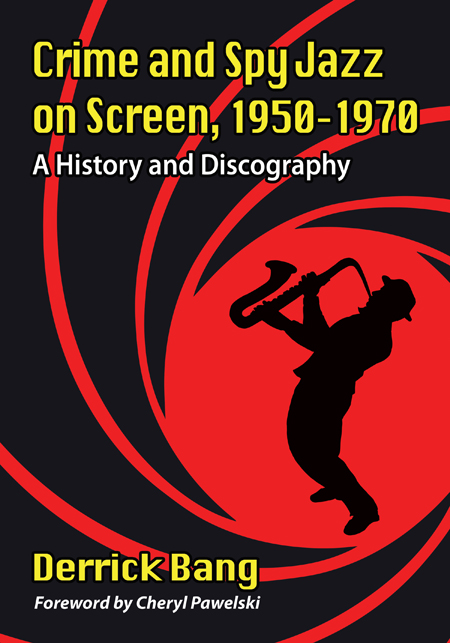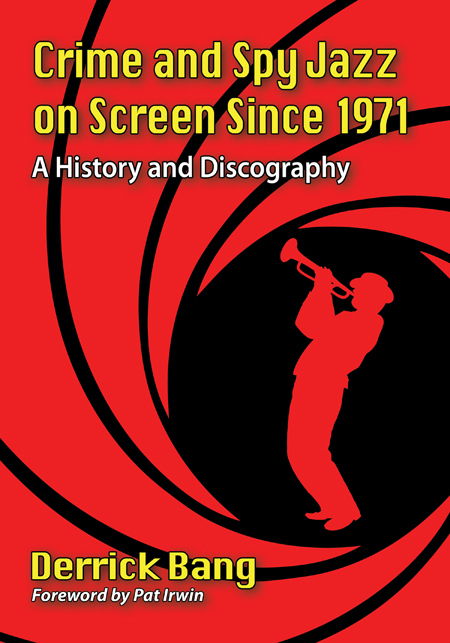
"Those Sensational Swing
Scores: Or How I Journeyed
from 1949’s Martin Kane, Private Eye
to 2018’s King of Thieves in Four
Years, Two Months, 17 Days, Six Hours and 43 Minutes"
By Derrick Bang, author of "Crime and Spy Jazz 1950-1970" and "Crime and Spy Jazz Since 1971" (McFarland)
I initially wanted to
write the ultimate guide to television’s Peter
Gunn. But some quick research revealed that it would be hard to improve
upon Joe Manning’s excellent two-part feature story in the June and July 2007
issues of Film Score Monthly
magazine; and Mike Quigley’s impressively thorough website guide to that iconic
1958-61 TV series (at www.petergunn.tv).
That said, Mike’s meticulously thorough analysis of the show’s music planted a
larger seed: perhaps a book about classic TV action jazz? Even there, though, a
few existing books — such as Kristopher Spencer’s Film and Television Scores, 1950-1979 — had covered that territory
to a degree.
So, go bigger still:
a survey of all television and film action/spy/detective jazz, with
a focus that I knew hadn’t yet been tackled. All that cool music by Henry
Mancini, John Barry, Lalo Schifrin, Edwin Astley, Quincy Jones, Jerry Goldsmith
and hundreds more. Aside from some scholarly works that go deep on a small
number of TV shows or films — such as David Butler’s Jazz Noir — nobody had undertaken the challenge to discuss so much
music in context. This became
obvious, as I began to build a library of research material, when I got the
distinct impression that many authors merely cited the existence of genre
soundtrack albums, perhaps even enthusing about the music itself, but without having watched the TV show or
movie from which it sprang. Too frequently, there was no sense of how a
soundtrack composer’s efforts helped — or sometimes hindered — the finished
product.
Thus armed with an
elevator pitch, I approached the McFarland & Co. editor (David Alff) who
had shepherded my 2012 biography of Northern California’s famed “Dr. Funk,†Vince Guaraldi at the Piano. David loved
the concept; a contract was signed. When pressed for a likely length, I naïvely
suggested 125,000 words.
Boy, was that off the mark.
The first phase was
the most difficult: determining a list of likely candidates. Paging carefully
through Tim Brooks and Earle Marsh’s Complete
Directory to Prime Time Network and Cable TV Shows (ninth and final
edition) yielded a lengthy list of potential small screen American candidates;
determining likely British entries proved more challenging, as did assembling a
similar list of big-screen feature films. I eventually wound up with 486 films
from 1950 to the present day, which featured crime/spy/action storylines, and
ultimately watched and analyzed 350; the others were discarded for their lack
of jazz scores. The task was far more challenging on the small screen, where
750 shows were considered from 1947 forward; 206 ultimately made the cut. And,
unlike a movie, which is a single (roughly) two-hour experience with music by
(usually) one individual, many of the TV shows necessitated the viewing of at
least half a dozen episodes, due to the involvement of multiple musicians.
You didn’t want to be
in the room while I was watching each entry, because of all the stopping,
sometimes backing up, and resuming … particularly if a soundtrack album
existed. As Cinema Retro’s soundtrack
fans are well aware, most early albums a) were studio re-recordings; and b)
assembled the tracks out of viewing order. So I’d hit a particularly choice
Johnny Mandel passage in (for example) 1958’s I Want to Live, and then search the album tracks until finding —
or, vexingly, not finding — the cue
in question. Over and over and over
again. Depending on quality and/or significance, each entry then generated an
essay of anywhere from a few paragraphs to three or four pages.

Roughly four years
later, the finished result came in just shy of 600,000 words. Okay, fine; first
drafts are over-written. As William Faulkner famously advised, “In writing, you
must kill all your darlings.†So I buried hundreds of them in the back yard,
and wound up with a more manageable 250,000 words. At which point, I knew that
further trimming would have deleted too much “good stuffâ€; the text would have
been compromised beyond repair, destroying the manuscript’s design as a truly
definitive study of this jazz sub-genre.
So I threw myself on
the altar of McFarland’s mercy, and — to my delight (and considerable relief) —
they okayed amending the contract for a two-volume set, thus preserving every
word of the final draft.
Having now emerged at
the far end of this jazz-laden journey, my music library (and the groaning
shelves in our small home) are much richer for the process that led to this
just-published result. And if these two books similarly pique your curiosity —
and correspondingly deplete your bank
account — then I’ll consider it a job well done.
(Derrick Bang has
written film, television, music and general entertainment commentary since the
mid-1970s, and is the author of several books about Charles M. Schulz and Peanuts. He can be reached at
www.screenactionjazz.com.)
CLICK HERE TO ORDER VOLUME 1 FROM AMAZON
CLICK HERE TO ORDER VOLUME 2 FROM AMAZON